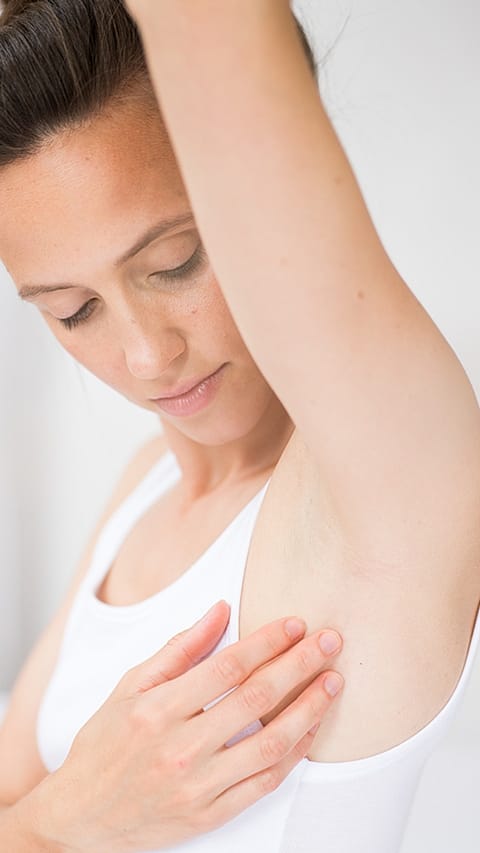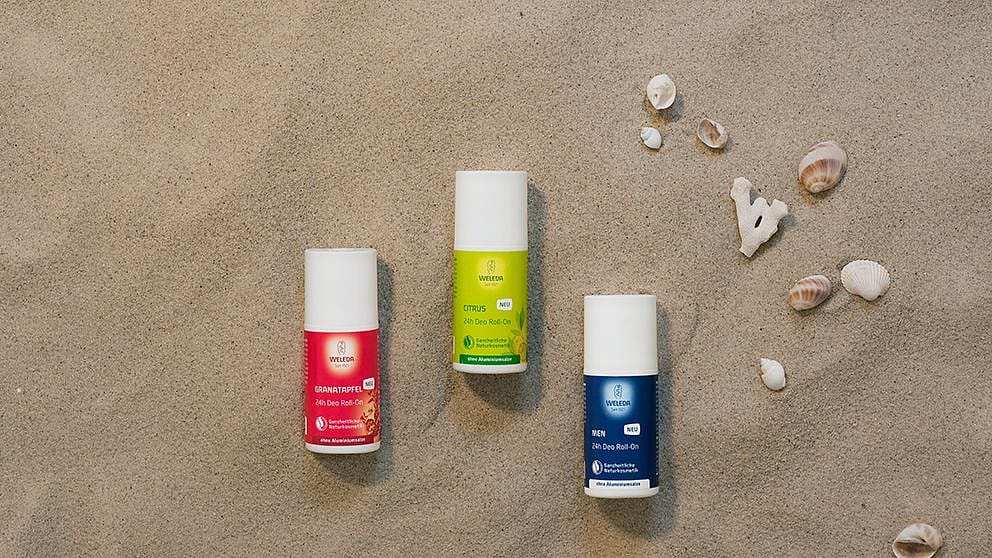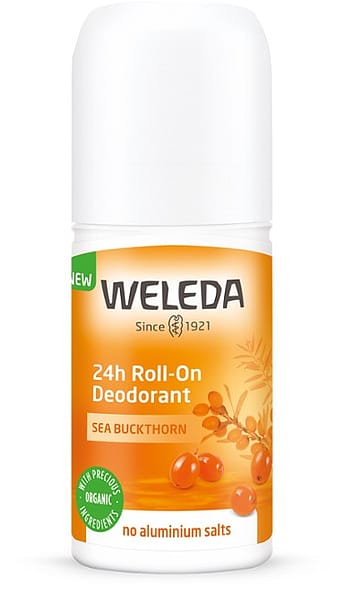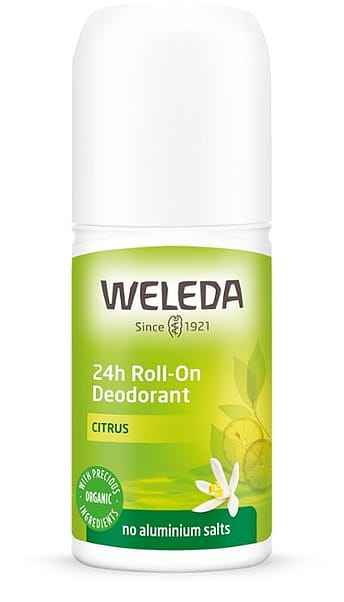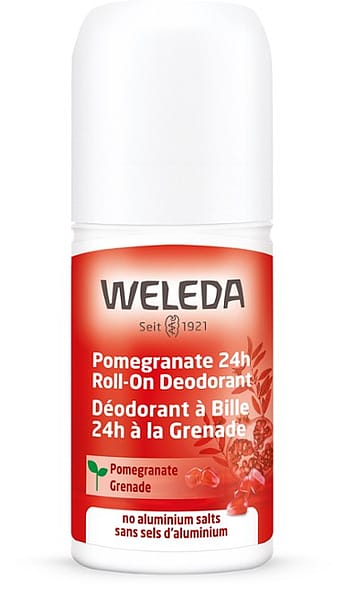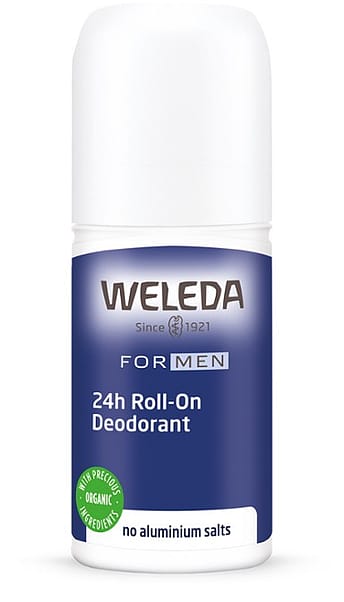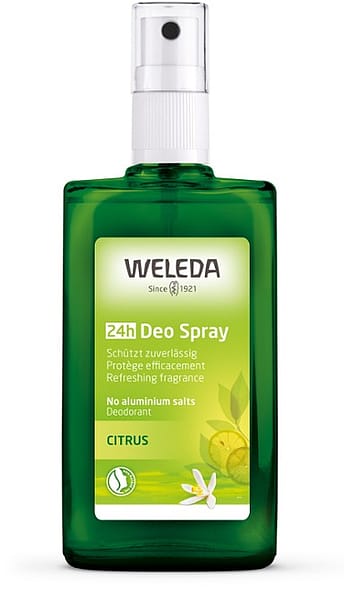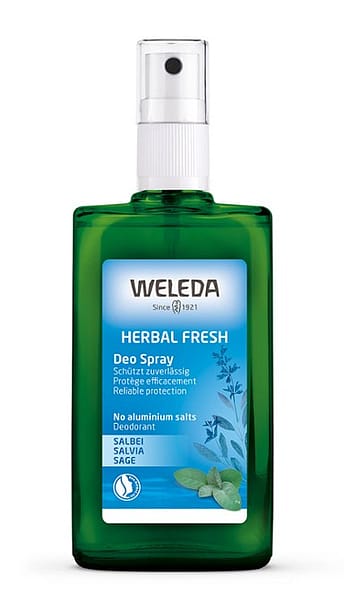Weleda cosmetic products do not contain any water-soluble aluminium compounds.
Deodorants without aluminium
Why do some deodorants contain aluminium, and why doesn’t Weleda use it?
Some deodorants contain aluminium, because it reduces the formation of sweat. But how does that work, and what kind of aluminium is used? Is aluminium harmful, or even carcinogenic? And are aluminium-free deodorants, like Weleda’s, just as good?
Difference between deodorant and antiperspirant
Some deodorant labels list INCI* ingredients such as “aluminum chlorohydrate” or “aluminum sesquichlorohydrate”. To understand why, it’s important to know the difference between a deodorant and an antiperspirant. A deodorant doesn’t suppress perspiration but counteracts the formation of odour or masks odour. An antiperspirant, on the other hand, controls odour by reducing the formation of sweat. Aluminium, or rather certain aluminium salts, are used to block the pores of our sweat glands for an antiperspirant effect.
*International Nomenclature of Cosmetic Ingredients
The element aluminium
Aluminium (chemical symbol Al) is the third most common element in the earth’s crust, after oxygen and silicon, and the most common metal. It is light, relatively soft and tough, and highly reactive. When exposed to air, aluminium quickly forms a thin oxide layer, which causes its typical dull, silver-grey appearance. This impenetrable oxide layer makes pure aluminium highly resistant to corrosion.
Due to its reactivity, aluminium occurs in nature almost exclusively in solid chemical compounds, for example in water-insoluble minerals such as clay, alumina, gneiss, granite or even in precious stones, like corundum and sapphire.
Aluminium is also found in many plants and fruits in the form of different salts. This is because plants can absorb dissolved aluminium compounds from the soil. Plants absorb aluminium to varying degrees. Tea bushes can contain high amounts (up to 5000 mg/kg dry weight), while other, taller-growing plants only contain around 200 mg/kg.
Aluminium as a trace element
Aluminium belongs to the trace elements, which are minerals that are absorbed into the body in small quantities through food, water or air. As a trace element, aluminium does not have any known functions in the metabolism of higher plants and animals. It is therefore classified as “non-essential” for humans, animals and plants, although in some plants such as ferns and horsetails it plays a vital role.
People absorb aluminium mainly via the gastrointestinal tract, and we excrete it again via the kidneys. There is sound scientific evidence that aluminium does not accumulate in the body if the kidneys are intact. However, if kidney function is impaired and aluminium exposure persists, symptoms of poisoning may occur.
Aluminium, Alzheimer’s and cancer
Too much aluminium can hinder bone formation in humans and possibly interfere with other processes in the body, such as leading to lower levels of calcium and magnesium. There is no scientific proof of a connection between symptoms of dementia and increased amounts of aluminium present in neuritic plaques characteristic of Alzheimer’s disease. These plaques are extracellular deposits in the brain; aluminium evidently has an affinity with these plaques and accumulates in them. There is no proven evidence that high dietary intake of aluminium (up to 850 mg/kg body weight per day in animal studies) can have a carcinogenic effect or could cause breast cancer.
Aluminium in cosmetics
- In total, about 50 different aluminium-containing substances are used in various cosmetic products. These substances have very different properties, such as water solubility or stability at different pH values.
- Water solubility in particular is very important for cosmetics. Only water-soluble substances can be metabolised by the body and therefore trigger a reaction, be it positive or negative.
- Substances containing aluminium are mainly used in deodorants and antiperspirants, lipstick, toothpaste, and also as a coating for UV filters in sunscreen.
Substances containing aluminium
50
different aluminium-containing substances are used in various cosmetic products
0
water-soluble aluminium compounds are contained in Weleda cosmetic producs
Aluminium salts in antiperspirants
Antiperspirants use mainly water-soluble salts, such as aluminium chlorohydrate. These salts are water-soluble at low, acidic pH values. The salts are dissolved in water for use in the product. When it is applied to the skin, the salts combine with sweat and skin, which have more neutral pH levels. This results in chemically inert, non-reactive complexes, with a relatively high molecular weight. The formation of these complexes keeps the aluminium-containing substances from penetrating through the skin and prevents the body from absorbing the aluminium. These complexes play a key role in the antiperspirant function. They plug the sweat ducts to prevent sweat from reaching the surface of the skin, so the skin remains dry.
There are no aluminium salts contained in Weleda deodorants – only ingredients of natural origin.
Weleda Deodorants
Weleda natural deodorants are not antiperspirants that block the pores to prevent sweat. There are no aluminium salts contained in Weleda deodorants – only ingredients of natural origin. These natural ingredients reduce the activity of bacteria that alter the composition of fresh, odourless sweat. It is only through this bacterial activity that the unpleasant smell of sweat arises. The essential oils used in Weleda deodorant sprays and roll-ons support the overall antimicrobial effect, which slows down the growth of bacteria and covers up the smell of sweat.
Sweating is healthy
Why doesn’t Weleda make antiperspirants? Our body controls its temperature mainly by sweating, since the evaporation of moisture on the skin’s surface cools it off. In addition to the circulation of blood through the skin and fatty tissue, this is an important way in which the body regulates its temperature. When we perspire, our body not only loses water, but also eliminates toxins and metabolites; sweating helps to cleanse the system. In fact, our body is constantly giving off sweat without us even noticing it. Along with the secretion of sebum, this skin activity is the organic basis for the spiritual experience of our body, our sense of body awareness.
Aluminium in lipstick, sunscreen and toothpaste
In lipstick, aluminium in the form of aluminium oxide is used in combination with organic pigments to make them insoluble. These are likewise complex structures with a high molecular weight, whereby the aluminium content is very low. In sunscreen, mineral UV filters are often coated with aluminium oxide. In toothpastes, water-insoluble minerals containing aluminium are often used as mild cleaning agents.
The European Scientific Committee on Consumer Safety (SCCS) has confirmed that aluminium-containing ingredients are “safe” for use as cosmetic raw materials. It also specified safe concentration limits for the presence of aluminium, depending on the product category. The SCCS concluded that the daily use of aluminium-containing cosmetic products is negligible compared to other sources, such as food. This means that the aluminium we have in our bodies is mainly absorbed through food – in comparison, the amounts we possibly absorb through cosmetics is very small.
Aluminium in Weleda natural cosmetics
Weleda cosmetic products do not contain any water-soluble aluminium compounds. However, in certain natural cosmetic products, Weleda uses different types of clays as a raw material, such as the naturally occurring clay with the INCI name “magnesium aluminum silicate”. This dermatologically well-tolerated raw material is used in some creams and toothpastes as an absorbing agent, consistency enhancer and emulsion stabiliser. In such water-insoluble minerals, the aluminium is firmly integrated into the crystal structure, which cannot be broken down by the body. Due to its size, the mineral cannot be absorbed through the skin or mucous membranes. Therefore, the aluminium which is chemically bound in this clay cannot enter the body.
“Aluminum-free” can be misleading
There’s no guarantee that a product is entirely “aluminium-free”, even with natural cosmetic products that don’t contain alumina clays. This is because the trace element may be present in other raw materials. Water, for example, naturally contains small amounts of aluminium, as do plants and therefore the plant extracts produced from them.



